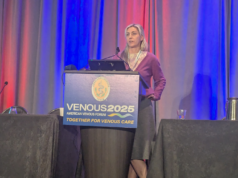
Bert van Meurs, the chief business leader for Image Guided Therapy with Royal Philips, speaks to Venous News following the company’s acquisition of Vesper Medical in December last year. He details how the procurement will further expand Philips’ portfolio of diagnostic and therapeutic devices, considers the specific challenges of working in the venous space, and outlines what is in the pipeline for Philips’ venous business in 2022.
What will the acquisition of Vesper add to the Philips business?
Philips’ Image Guided Therapy strategy is centred around delivering more complete solutions. In the venous disease space, our teams already have a strong presence with our imaging labs—not only in hospitals but also now in office-based labs (OBLs), where more and more venous procedures are taking place. In addition, every venous procedure requires intravascular ultrasound (IVUS), and most of the IVUS that is being used during venous procedures is provided by Philips. When it comes to treatment, however, we do not have our own device, our own venous stent. A venous stent is different to either a coronary or peripheral stent in that it needs to be strong enough to keep the vein open, but also flexible enough so that it does not kink. The hybrid design of the Vesper Duo venous stent offers both flexibility and strength, and therefore a good addition to our venous offering.
Philips was originally positioned in the systems space and has, for the last decade or so, been moving into the device space. How has this process evolved?
Around 10 years ago, we decided to move beyond our imaging capabilities and focus on the procedure and how we can help treat patients better. We started to think about how we could make navigation smarter, how we could develop instruments and devices that would guide themselves and therefore use fewer X-rays, or even have the ability to visualise and therefore not use X-ray at all. We developed our own technologies that helped to innovate procedures, but we also came to the realisation that we were, in essence, an imaging company that sold systems. Companies in the device space have a different business model, a different way of working, and we recognised that an effective way to develop in that space was to acquire those capabilities. When considering a company for acquisition, we look not only at its product portfolio, but also at its potential to help design and develop Class III medical devices and conduct premarket approval (PMA) clinical trials.
We first acquired Volcano, seven years ago, followed by Spectranetics, Intact Vascular, and now Vesper. We continue to build this device business within the Image Guided Therapy space, not as a separate business but as one that is integrated within the imaging component. We also think about how we can leverage imaging and devices together in the pursuit of our overall strategy to innovate the whole procedure, and we will continue to do so in disease-specific applications, so coronary artery disease, peripheral arterial disease, and now also venous disease. We are looking at other areas as well.
What do you think are the specific challenges of working in the venous space?
I think one of the biggest challenges is creating more awareness. Awareness of the severity of the disease among patients, and indeed physicians, is very often underestimated. If patients do not get treated or are treated too late, the consequences can be severe—a patient can lose their leg as a result of venous disease, and it can even be fatal. Another challenge is creating better solutions for patients in a lower-cost, easy-to-access care setting. This is where OBLs can offer a solution.
What are going to be some of the milestones for Philips’ venous business in 2022?
Our first aim is to finalise the Vesper Duo stent PMA approval, and then work with the US Food and Drug Administration (FDA) on the final approval. That is the main focus. We will also put focus on making sure that the team that created the stent can leverage the strengths of Philips, accelerate and do things that they could not do as a standalone company.
The venous space is not new to us—through our imaging and IVUS portfolios we are already there—and we have fantastic customer relations as well as a number of key thought leaders who we already work with, and who we can immediately leverage. The difference now is that we can collaborate with a much larger network of thought leaders in the venous space.









